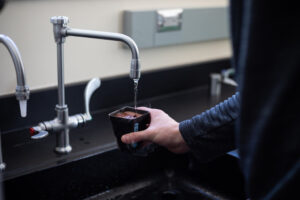Astrobotany, the study of plants in space, dares to ask if the fields and forests of Earth could one day thrive on other worlds. In this January Term course taught by biology instructor Reina Nielsen ’16, students have a unique opportunity to scientifically explore possibilities pulled straight from sci-fi.
By studying how plants respond in space environments, the goal of astrobotany is to supplement and eventually supply astronauts’ diets from plants grown on the International Space Station and even other planets.
“We’re basically testing how plants are responding to really extreme conditions, and as Earth continues to go through climate change, those extreme conditions might be comparable to something we might see on Earth,” said Nielsen. “So heat stress, potentially water stress, any of those main stressors that we’re testing in space can be applicable here on Earth.”
While students won’t actually get to study plants in space, they will complete a few hands-on labs, testing how Earth’s gravity and light sources affect plant growth, as well as a science fiction inspired lab. Plus, they’re learning about the advancements currently being made in astrobotany, like the chile peppers recently grown on the International Space Station.

In an experiment inspired by The Martian by Andy Weir, students are growing plants in replica Martian soil. In the book, the main character grows potatoes in Martian soil with added human waste, allowing him to survive on Mars. In a less life-and-death situation, the astrobotany class will add Gustavus compost to the replica soil to see if they can get plants to grow.
“I’ve always loved science fiction, including those stories about trying to survive on a spaceship on Mars. I studied plants in grad school, and I really enjoyed looking at plants at their extremes, and so I thought this was a great mesh of my two interests,” Nielsen said.
As an introductory level class, business, art, and biology majors alike are learning a broad overview of botany. “It’s a pretty niche subject, but I’m super excited to get the opportunity to learn about it,” said Taisha Linder ’25, a potential biology major. “I also love that it combines my interests in both plants and space.”
Gustavus’s January Term is all about innovation and finding interdisciplinary connections, as well as expanding on the interests of students and faculty. “I hope students take away a fascination of plants,” said Nielsen, “but also take away that curiosity of what can be possible, where can science bring us.”